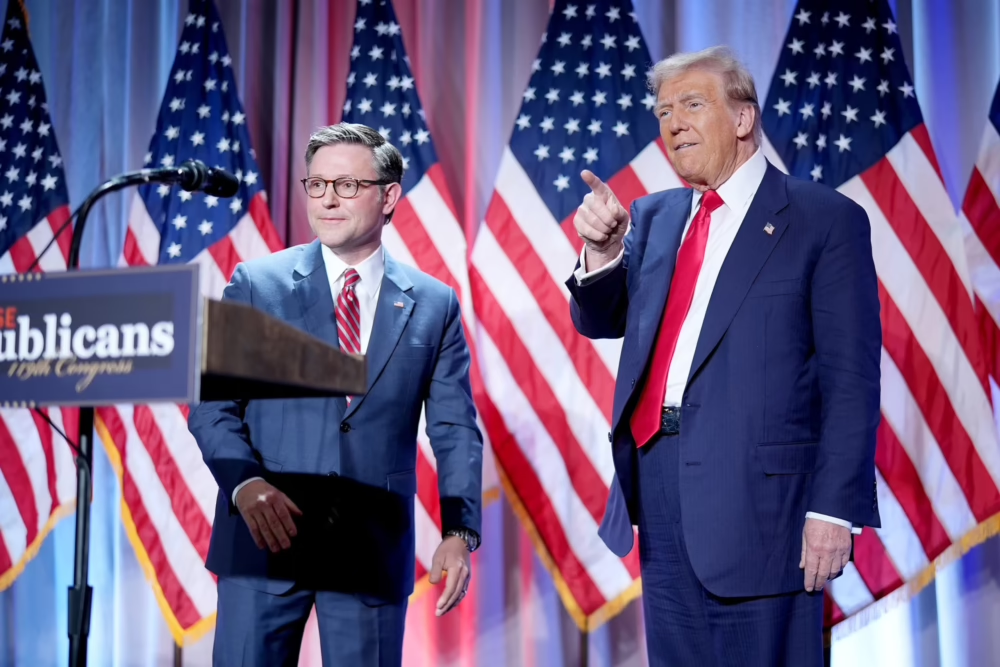Trump’s Influence and Challenges Ahead: A Dramatic Speaker Vote Marks a New Era for Mike Johnson the GOP

In a dramatic scene on the House floor, President-elect Donald Trump stepped in to help secure Rep. Mike Johnson’s election as Speaker of the House, demonstrating the immense power he continues to wield within the Republican Party. Johnson, a Louisiana Republican, narrowly won the speakership after Trump personally intervened in a high-stakes vote, making it clear that GOP unity was essential to navigating the turbulent political landscape ahead. This episode not only highlighted Trump’s enduring influence but also underscored the challenges he will face in steering his agenda through a deeply divided Congress.
Trump’s Strategic Role in the Speaker Vote
The Speaker vote of the 119th Congress was an early test of Trump’s ability to marshal Republican support, and it played out in dramatic fashion. With just two GOP lawmakers holding out against Johnson, Trump made a decisive move. In an effort to prevent a drawn-out battle that could fracture the Republican Party, Trump directly lobbied hesitant lawmakers, even picking up the phone to speak with key holdouts. As one lawmaker later recounted, Trump’s message was clear: “Republicans need to work as a team or risk a dysfunctional Congress.”
Johnson’s victory in securing the Speaker’s gavel, however, was far from guaranteed. While he ultimately secured the necessary 218 votes, the process was fraught with uncertainty, and it wasn’t until Trump’s intervention that the tide turned in his favor. According to Rep. Andy Biggs, a conservative hardliner from Arizona, Trump’s endorsement was pivotal in convincing skeptical Republicans to fall in line. “Without Trump’s backing, Johnson’s speakership would not have been possible,” Biggs admitted.
Trump’s involvement in the Speaker race marked a crucial moment in his ongoing influence over the Republican Party. While he initially hesitated to weigh in, Trump’s endorsement became the deciding factor for many in the GOP, reflecting his continued dominance as a political force.
Narrow Republican Majorities and Governing Challenges
Trump’s intervention in the Speaker vote was just the latest example of the uphill battle he faces in governing with a divided Congress. Although the GOP controls the White House and both chambers of Congress, the narrow majorities in the House and Senate mean that Trump cannot afford to lose even a handful of votes if he hopes to pass legislation and fulfill his campaign promises.
Despite having the Speaker’s seat secured, the challenges ahead are significant. The GOP’s slim majority in the House is likely to get even tighter if Trump’s allies, such as Reps. Mike Waltz and Elise Stefanik, are confirmed to key positions in his administration. This only adds to the pressure on Trump to keep the Republican Party united, particularly as the 2026 midterms approach.
The difficulty of governing with a fragmented Republican Party was evident in the 2022-2024 period. During this time, Trump struggled to sway his party on key issues, such as raising the country’s borrowing limit and securing his preferred Senate majority leader. Even more recently, he faced resistance in influencing state-level politics, with Florida Gov. Ron DeSantis rejecting his pick for a Senate seat.
As former Rep. Patrick McHenry of North Carolina put it, “It’s going to be a dicey run for this House Republican majority.” The slim margins mean that Trump will need near-unanimous support from his party—or bipartisan backing—to move forward with his legislative agenda.
Johnson’s Approach: No Major Giveaways
One of the most striking aspects of Mike Johnson’s path to the Speaker’s gavel was his refusal to make the typical concessions that often accompany such a position. Unlike his predecessor Kevin McCarthy, who made significant trade-offs with his detractors in exchange for support, Johnson took a different approach. He was resolute in his commitment to empowering individual lawmakers without offering the usual promises of committee slots or special bills.
Johnson’s decision not to bow to the demands of hardliners in the GOP, particularly those within the House Freedom Caucus, helped maintain his political integrity. He emphasized that his approach to leadership would be centered around empowering the entire Republican caucus, not just catering to specific factions within the party. This focus on member empowerment gave Johnson more flexibility to operate in one of the narrowest majorities in U.S. history.
Despite these clear signals of resistance to traditional bargaining tactics, Johnson’s victory did not come without strings attached. Some conservatives, including Rep. Chip Roy of Texas, continued to push for significant reforms, such as spending cuts and a more robust appropriations process. Johnson responded by establishing a working group to address government efficiency—an initiative that would align with Trump’s new Department of Government Efficiency, led by Trump ally Elon Musk and former presidential candidate Vivek Ramaswamy.
Trump’s Long-Term Vision: Keeping the GOP United
Trump’s influence in securing the speakership for Johnson is a reminder of his long-term vision for the Republican Party. While the Speaker’s vote provided a brief moment of success, Trump faces a much more complex task in the years ahead: keeping a fractious party united as the 2026 midterms approach. The GOP’s slim majorities in the House and Senate mean that Trump must continually work to maintain his grip on the party, even as diverse factions within the GOP vie for influence.
Trump’s ability to rally Republicans behind his agenda will be crucial to his success over the next two years. As Rep. Tom Cole of Oklahoma noted, “Trump had a lot of influence in this vote, and it’s clear that his role in the speakership race was critical to its outcome.” But this influence will be tested in the coming months, particularly as Trump attempts to push forward his legislative priorities and balance the demands of various factions within his party.
As the Republican Party gears up for the 2026 elections, Trump’s ability to navigate the delicate political dynamics within his party will be one of the key factors determining his success. With a narrow majority in the House, a divided Senate, and an increasingly vocal group of conservative hardliners, the next two years will be a test of Trump’s ability to maintain control over the GOP while delivering on his ambitious agenda.
Conclusion: A Test of Leadership
The Speaker vote and its aftermath serve as a critical early indicator of the challenges Trump will face in his bid to lead the country over the next two years. While his intervention played a decisive role in securing the speakership for Mike Johnson, the coming months will reveal whether Trump can continue to hold his party together and push through his policy goals. With a fragmented GOP and mounting political pressures, Trump’s leadership will be put to the ultimate test as he navigates the complexities of governing in a divided Congress.
As the GOP heads into the 2026 midterms, one thing is clear: Trump’s political influence remains a force to be reckoned with, but the coming years will demand that he continually prove his ability to unite a fractured party and deliver on his promises to the American people.



0 Comment